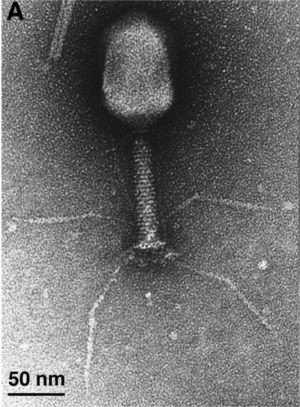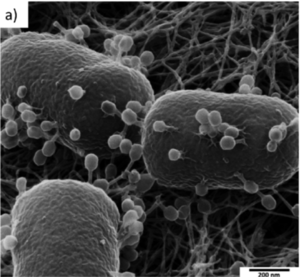T4 Bacteriophage: Difference between revisions
No edit summary |
|||
| Line 1: | Line 1: | ||
{{Uncurated}} | {{Uncurated}} | ||
[[Image:Bacteriophage T4 electron micrograph a.png|thumb|300px|right| | [[Image:Bacteriophage T4 electron micrograph a.png|thumb|300px|right|Electron micrograph. Image credit: Fumio Arisaka. Publication: Bacteriophage T4 Genome https://doi.org/10.1128/MMBR.67.1.86-156.2003.]] | ||
[[Image:T4 Bacteriophage infecting Ecoli.png|thumb|300px|right| | [[Image:T4 Bacteriophage infecting Ecoli.png|thumb|300px|right|Helium Ion Micrograph. Image credit: Name or Publication.]] | ||
==Classification== | ==Classification== | ||
Revision as of 23:53, 11 December 2022

Classification
Viruses (Superkingdom); Duplodnaviria (clade); Heunggongvirae (kingdom); Uroviricota (phylum); Caudoviricetes (class); Straboviridae (family); Tevenvirinae (subfamily); Tequatrovirus(genus); Tequatrovirus T4(species)
You may notice the absence of a domain in the classification above. This is because bacteriophages, which are viruses, are not alive!
Species
|
NCBI: [https://www.ncbi.nlm.nih.gov/Taxonomy/Browser/wwwtax.cgi?mode=Info&id=1007084&lvl= 3&lin=f&keep=1&srchmode=1&unlock] |
Official name from Taxonomy Browser: Tequatrovirus T4
Current name: Escherichia phage T4
Commonly known as: Bacteriophage T4
Genome Structure
Describe the size and content of the genome. How many chromosomes? Circular or linear? Other interesting features? What is known about its sequence?
Cell Structure, Metabolism and Life Cycle
Interesting features of cell structure; how it gains energy; what important molecules it produces.
The T4 bacteriophage has the classic appearance that most people think of when they hear the term bacteriophage. If you were going to observe a T4 bacteriophage, you would notice two main parts of the virus' body; the head, and the tail. The head is comprised of an icosahedral (20 sided) capsid, that contains T4's _______ stranded _NA, and is the proximal part of the virus. The whole tail region has a few more parts, and is located distally to the icosahedral capsid. The proximal end of the tail is where the collar can be observed, and the distal end of the tail is where the baseplate can be observed. Extending laterally from the baseplate are six tail fibers that can be easily mistaken for legs. Despite being a virus, these tail fibers give T4 a very live appearance. Beneath the baseplate there is a spike that the bacteriophage uses to inject its genome into the host for replication.
The T4 bacteriophage is still quite smaller than its host, Escherichia coli. While Escherichia coli is a couple of micrometers, T4 is an entire order of magnitude smaller. The T4 bacteriophage is roughly ______ nM (nanometers) tall. In addition to being smaller than the host, T4 is also much more abundant than its host, outnumber E. coli nearly _____ to one.
Ecology and Pathogenesis
Habitat; symbiosis; biogeochemical significance; contributions to environment.
If relevant, how does this organism cause disease? Human, animal, plant hosts? Virulence
factors, as well as patient symptoms.
Bacteriophages were discovered just over a century ago, more than a decade before the discovery of penicillin. Even though penicillin took the spotlight in mainstream medicine, the medical potential of bacteriophages has not gone unrecognized. While antibiotics are fast acting, and easier to administer they don't have the precision of a phage. Penicillin is a broad spectrum antibiotic, meaning it doesn't just kill pathogens but also kills harmless or even beneficial bacteria that are exposed to it. Meanwhile bacteriophages are host specific down to at least a species level. That means that a lytic bacteriophage can kill its host organism, and any other bacteria that are exposed to the predator-prey relationship between T4 and Escherichia coli are simply bystanders and remain unharmed.
Phage-host coevolution:
Lytic cycle:
Lysogenic cycle:
History & Significance
Bacteriophages were discovered just over a century ago, more than a decade before the discovery of penicillin. Even though penicillin took the spotlight in mainstream medicine, the medicinal potential of bacteriophages has not gone unrecognized. While antibiotics are fast acting, and easier to administer they don't have the same level of precision as a bacteriophage. Penicillin is a broad spectrum antibiotic, meaning it doesn't just kill pathogens but also kills harmless or even beneficial bacteria that are exposed to it. Meanwhile bacteriophages are host specific down to at least a species level. That means that a lytic bacteriophage can kill its host organism, while any other bacteria are simply bystanders and remain unharmed.
How to draw a detailed bacteriophage
References
[Sample reference] [http://ijs.sgmjournals.org/cgi/reprint/50/2/489 Takai, K., Sugai, A., Itoh, T., and Horikoshi, K. "Palaeococcus ferrophilus gen. nov., sp. nov., a barophilic, hyperthermophilic archaeon from a deep-sea hydrothermal vent chimney". International Journal of Systematic and Evolutionary Microbiology. 2000. Volume 50. p. 489-500.]
NCBI NLM Taxonomy Browser. https://www.ncbi.nlm.nih.gov/Taxonomy/Browser/wwwtax.cgi
NIH NCBI Virus. https://www.ncbi.nlm.nih.gov/labs/virus/vssi/#/virus?SeqType_s=Nucleotide&VirusLineage_ss=Escherichia%20phage%20T4,%20taxid:2681598
Miller, Eric & Kutter, Elizabeth & Mosig, Gisela & Arisaka, Fumio & Kunisawa, Takashi & Rüger, Wolfgang. (2003). Bacteriophage T4 Genome. Microbiology and molecular biology reviews : MMBR. 67. 86-156, table of contents. 10.1128/MMBR.67.1.86-156.2003.
Schmidt, Matthias & Byrne, James & Maasilta, Ilari. (2021). Bio-imaging with the helium-ion microscope: A review. Beilstein Journal of Nanotechnology. 12. 1-23. 10.3762/bjnano.12.1.
Author
Page authored by Jake Delaney, student of Prof. Bradley Tolar at UNC Wilmington.

